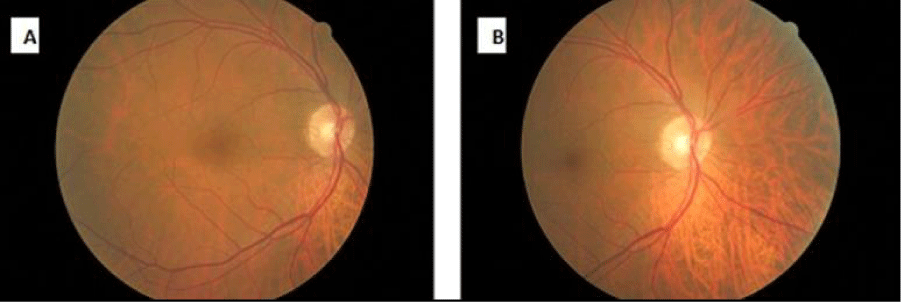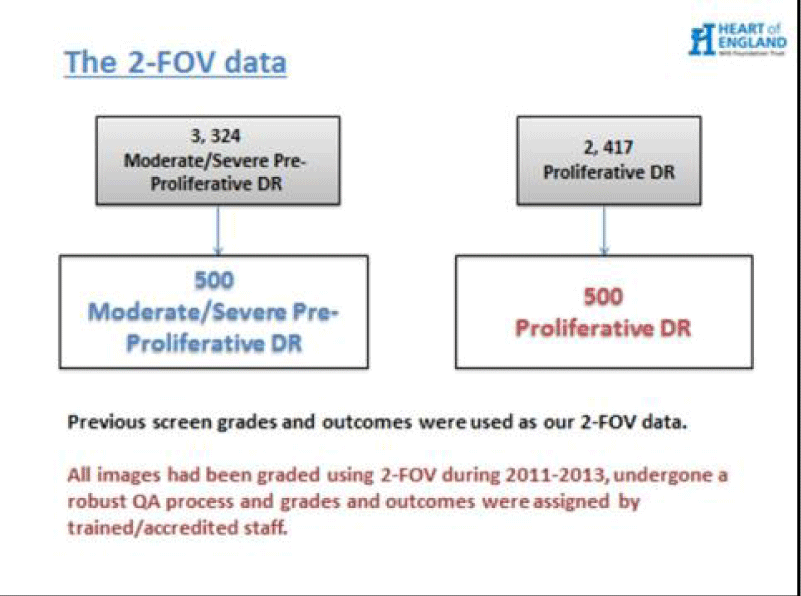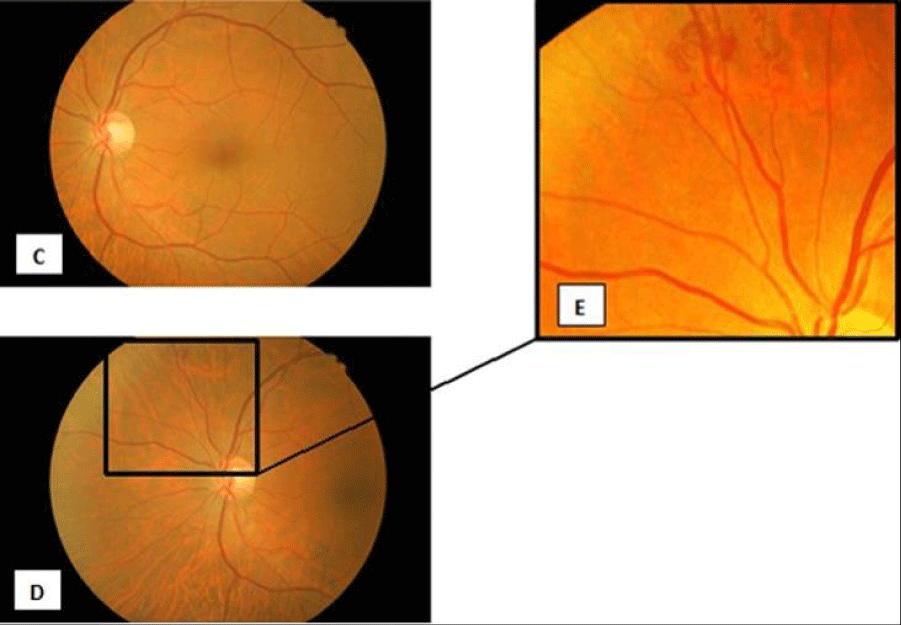One-Field of View vs. Two-Fields of View; Is a Macula Centered Photograph Adequate for Diabetic Retinopathy Screening?
Mirriam Shah1*, Hannah Fellows1, Helen Wharton1, Laurence Quant1 and Paul Dodson1,2
1Departments of Diabetes and Ophthalmology, Heartlands Hospital, Birmingham, UK
2School of Health and Life Sciences, Aston University, Birmingham, UK
*Address for Correspondence: Mirriam Shah, Diabetes & Endocrinology Centre, Birmingham Heartlands Hospital, Bordesley Green East, Birmingham, B9 5SS, Tel: +0121-424-2039; Fax: +0121-424-2982; E-mail: [email protected]
Submitted: 01 March 2017; Approved: 20 March 2017; Published: 28 March 2017
Citation this article: Shah M, Fellows H, Wharton H, Quant L, Dodson P. One-Field of View vs. Two-Fields of View; Is a Macula Centered Photograph Adequate for Diabetic Retinopathy Screening?. Int J Ophthal Vision Res. 2017;1(1): 001-005.
Copyright: © 2017 Shah M, et al. This is an open access article distributed under the Creative Commons Attribution License, which permits unrestricted use, distribution, and reproduction in any medium, provided the original work is properly cited
Download Fulltext PDF
Aim: To compare one Field Of View (1 - FOV) and two Field Of View (2 - FOV) photography for diabetic retinopathy detection by assessing and comparing disease level and outcome.
Methods: A retrospective audit of a random sample of 500 patients with known proliferative diabetic retinopathy (PDR or R3), and 500 non-proliferative diabetic retinopathy (NPDR or R2). Images were re-assessed according to the English program criteria for DR levels using 1-FOV.
Results: Using 1-FOV; in 387 (77.6%) of the 500 PDR patients, the DR level was agreed and referred urgently into the eye clinic. In the remaining 112 (22.4%) DR levels were downgraded.
Using 1-FOV; in 297 (59.4%) of the 500 NPDR patients the retinopathy level was agreed and referred routinely into the eye clinic. The remaining 203 (40.6%) were downgraded. Of these patients, 115 (56.6%) would have been routinely referred into the eye clinic due to the presence of surrogate markers for macula edema only and 88 (43.4%) to annual screening.
Conclusion: Using 2-FOV photography allows for an increased view of the peripheral retina and identification of advanced DR. In contrast, 1-FOV did not show PDR (R3) in 1 in 5 cases and NPDR (R2) in 2 in 5 as both DR levels assigned and of concern clinical outcomes were altered. Therefore 1 - FOV is not identifying serious DR levels in a number of cases with potential adverse significance to clinical ocular outcomes. This audit supports that 2-FOV is superior in accuracy of identification of levels of diabetic retinopathy compared to 1-FOV.
Introduction
Undetected and untreated Diabetic Retinopathy (DR) is one of the leading causes of blindness amongst the working-age population in the UK [1]. Diabetes damages the micro-vascular structure in the retina causing ischemia and leakage [2]. The degree of vessel damage correlates with the progression of clinical features and advancement of retinopathy stages. Improvement of diabetic and blood pressure control has been shown to delay or prevent the progression of DR and intravitreal treatment/laser treatment in the more advanced phase. However, laser, though effective for stabilizing the progression of DR does not usually restore visual loss [3,4].
Early manifestations of DR can be located in the central as well as the peripheral retina and often does not impact upon vision until it reaches the more advanced stages; therefore routine retinal examinations are important for prompt diagnosis and treatment. The National Diabetic Eye Screening Program (NDESP) in England provides systematic digital retinal camera screening of all patients who have diabetes for the presence of DR, with an aim to reduce the risk to vision of Sight Threatening Diabetic Retinopathy (STDR) and minimize subsequent visual loss. Two-field of view (2-FOV) digital retinal photography one macula and one disc centered is the accepted method of systematic screening for DR in the English DR screening program. This approach has shown to be able to meet the established and widely accepted standards outlined for an effective screening program by the NDESP and achieve a high level of sensitivity (80%) and specificity (90%). However it has been argued that only one retinal image centered on the fovea is necessary for effective screening [5,6]. Whilst this approach may prove cost and time effective, with the added benefit of reduced server storage space requirements, it is likely that more images will identify more diabetic retinopathy lesions. Thus using one image centered on the macula in isolation will only cover a minority of the retina (> 15% of the total retina). Equally seven field photography as practiced in the Early Treatment Diabetic Retinopathy Study (EDTRS) protocols and used for research is not feasible for annual screening purposes due to poor acceptability to patients, time and cost. The purpose of this audit was to investigate the results of capturing 2 retinal views (one centered on the macula and one centered on the optic disc, see figure 1 compared to the retinal findings from a single macula centered image, to assess the impact to screening of the additional image in terms of level of DR and clinical outcome.
Participants and Methods
The screening method employed in the English NDESP is digital retinal photography through dilated pupils of two 45 degree fields of each eye, one fovea centered and the other optic disc centered. A robust quality assurance system is in place whereby all abnormal photographs are re-assessed and reviewed by an ophthalmologist if referable retinopathy is identified (Table 1). For the purpose of this audit, we retrospectively selected patients with diagnosed referable diabetic retinopathy (PDR/R3, and moderate to severe NPDR/R2 levels). All patients were screened and images were assessed between 2011 - 2013 using 2 - FOV digital retinal photography in the Birmingham, Solihull and Black Country (BSBC) DESP. A selection of 500 patients with moderate/severe pre-proliferative retinopathy (R2/NPDR) from a total population of 3,324 and 500 patients with proliferative DR (R3/PDR) from a total population of 2,417 (Figure 2) were chosen at random. All image sets were re-assessed according to our local DR disease level criteria (see table 1) using only the macula centered view (1-FOV). A retinopathy level and outcome was assigned according to the national protocols (R0, R1, R2 or R3), which determined the clinical outcome as annual screen, routine or urgent referral to the ophthalmology clinic, respectively. The retinopathy level from the patient’s screening episode with 2-FOV photography was accepted as the true screening outcome following the robust grading protocol of the BSBC programme defined by the NDESP. All images were assessed by experienced, trained and accredited retinal grading staff. In order to reduce biasing of assigning a level of DR with the macula image alone, images were masked to previous grading level and double assessed (by MS and HF) and disagreements in level were arbitrarily assessed by a further masked senior staff at our centre (12% of cases). Comparison was then made with the result of one field to two field retinal photography in difference in DR level and clinical outcome. The outcomes did not include maculopathy level particularly relevant to reflection and artefact or assessability (whether two images improve gradability and allow for subsequent safe assessment).
Results
Proliferative diabetic retinopathy (PDR or R3)
When assessing images using the macula centered view only (1 - FOV); 387 (77.6%) of the 500 patients with definite proliferative retinopathy on 2 field retinal images were confirmed and would therefore have been referred urgently for ophthalmological clinical assessment correctly. The remaining 112 (22.4%) were downgraded to moderate/severe pre-proliferative DR (NPDR or R2) or background DR (BDR or R1). Of these; the clinical outcome would be altered to 96 (85.7%) with routine referral for ophthalmology clinical assessment and of major concern 17 (14.3%) kept on annual screening (Figure 3).
Pre-proliferative retinopathy (R2 or NPDR)
Of the 500 patients with pre-proliferative DR (R2 or NPDR), on 1-FOV, the retinal level was agreed in 297 patients (59.4%) and would have been referred routinely for ophthalmology clinical assessment correctly. The remaining 204 (40.6%) were downgraded to background DR (R1 or BDR). The clinical outcome was therefore consequently changed, with 88 patient’s (43.4%) continuing annual screening rather than referral for ophthalmology assessment. However in the remaining 115 (56.6%) referable Maculopathy (M1) was identified thereby resulting in a routine referral for ophthalmology assessment anyway. Thus the clinical outcome was downgraded in smaller numbers in this group in 88 patients (43.4%) owing to coexisting referable Maculopathy (M1).
Discussion
In this audit groups of patients who were known to have PDR (R3) or severe moderate pre-proliferative (R2/NPDR) DR, using 2-FOV photography, all of whom required a referral into the eye clinic, either urgently or routinely were assessed for DR disease levels using the single macula centered photograph. Based on the findings of this large audit there is a clear critical advantage of an additional image, demonstrating that 1-FOV DR levels compared with 2-FOV resulted in 1 in 5 PDR (R3) and 2 in 5 severe/moderate pre-proliferative (R2) cases being downgraded with altered clinical outcomes. This illustrates that 1-FOV grading maybe an inadequate tool for DRS, particularly in patients with high risk retinopathy status. Therefore 2-FOV digital retinal photography allows for an increased view of the peripheral retina and a more accurate identification of proliferative DR (PDR or R3) and moderate/severe pre-proliferative changes (NPDR or R2). The value of multiple FOV photography is further supported by several earlier studies [7-9]. Kuo, et al. [7] concluded that single field photography is inadequate for Diabetic Retinal Screening (DRS) whilst Vujosevic, et al. [9] found that 1-FOV grading gave a sensitivity value of 71% which is considered too low for an effective screening program and failed to meet Exeter standards.
Comparing our results with other reports that have asked similar questions is challenging because it is apparent there are many variations in criteria for DR levels, smaller sample sizes, methods and reference parameters that are used. This may contribute to the conflicting results where studies have shown that 1-FOV is inadequate [7,9]; others demonstrate its adequacy for screening [10-12] and have affirmed there is no statistically significant difference between 1 - FOV and multiple view photography [10,11], thereby implying that multiple FOVs may be a waste of valuable time and NHS resources. This audit has not answered the issue of whether more images than 2 would be more effective or clinically worthwhile to the screening outcome. One study suggested that the use of 3-FOV does not improve the sensitivity or specificity for the detection of any retinopathy or of referable retinopathy [12]. The introduction of Ultra-Wide Field (UWF) technology for DRS is becoming an area of increased research. There are published studies that state that larger coverage of the retina can lead to detection of more DR lesions outside the standard 7-fields and this influences DR severity levels and subsequent clinical outcomes [13,14]. UWF imaging has technical limitations and it is not an approved method for DRS. However it does help illustrate the advantage of capturing 2 x 45 degrees image of the retina and the potential of improving the detection of DR identification that would otherwise be overlooked in 1 x 45 degree image and in turn improve patient outcomes as more of the peripheral retina is visible. Our audit did not determine the cost effectiveness of each method of screening. It is likely however that there will be additional benefit to capturing 2 images that are not recorded in this audit with regards to macula glare and artifact, other lesions in the peripheral nasal field as well as assess ability in groups of patients who present with lens opacities. A limitation with this investigation is that those involved in the audit were aware that all image sets would be of patients who had signs of referable DR (R2 and R3) using 2-FOV photography but the actual (2 FOV) DR levels were masked. There could have been a bias to be reluctant to downgrade image sets but the observed difference is large and this limitation would work to minimize difference.
Conclusion
We conclude from our large audit results that the use of both macular and disc centre images at a 45 degree field represents the better screening strategy as it provides a more accurate identification of referable DR than 1 - FOV photography and that this has a significant impact on clinical outcomes. Thus a 2 - FOV digital retinal imaging protocol should be considered for new DR screening programs.
Previously presented at EASDec (European Association for the Study of Diabetic eye complications) conference held in Padova, Italy May 15-17, 2014.
- Nentwich MM, Ulbig MW. Diabetic retinopathy - ocular complications of diabetes mellitus. World J Diabetes. 2015; 6: 489-499. https://goo.gl/WnXL3q
- Klein R, Klein BE, Moss SE, Cruickshanks KJ. The Wisconsin Epidemiologic Study of diabetic retinopathy. XIV. Ten-year incidence and progression of diabetic retinopathy. Arch Ophthalmol. 1994; 112: 1217-1228. https://goo.gl/eYUwRw
- The diabetic retinopathy study research group. Photocoagulation treatment of proliferative diabetic retinopathy; the second report of diabetic retinopathy study findings. Ophthalmology. 1978; 85: 82-106. https://goo.gl/QGRVRO
- The diabetic retinopathy study research group. Photocoagulation treatment of proliferative diabetic retinopathy. Clinical application of Diabetic Retinopathy Study (DRS) findings, DRS Report number 8. Ophthalmology. 1981; 88: 583-600. https://goo.gl/fGyoL7
- George AW, Ingrid US, Julia AH, Albert MM, Dennis MH, Richard M. Single-Field Fundus Photography for Diabetic Retinopathy Screening. A Report by the American Academy of Ophthalmology. 2004; 111: 1055-1062. https://goo.gl/DOXZh2
- Suansilpong A, Rawdaree P. Accuracy of single field non mydriatic digital fundus image in screening for diabetic retinopathy. J Med Assoc Thai. 2009; 91: 1397-1403. https://goo.gl/1DVe7c
- Kuo HK, Heish HH, Liu RT. Screening for diabetic retinopathy by one field, non mydriatic, 45 degrees digital retinal photography is inadequate. Ophthalmologica. 2005; 219: 292-296. https://goo.gl/zWpFK1
- Boucher MC, Gresset JA, Angioi K, Oliver S. Effectiveness and safety of screening for diabetic retinopathy with two non-mydriatic digital images compared with the seven standard stereoscopic fields. Can J Ophthalmol. 2003; 38: 557-568. https://goo.gl/0Fs9qB
- Vujosevic S, Benetti E, Massignan F, Pilotto E, Varano M, Cavarzeran F, et al. Screening for DR: 1 and 3 non-mydriatic 45 degree digital fundus photographs vs 7 standard early treatment diabetic retinopathy study fields. Am J Ophthalmol. 2009; 148: 111-118. https://goo.gl/uR1pbu
- Olson JA, Strachan FM, Hipwell JH, Goatman KA, McHardy KC, Forrester JV, et al. A comparative evaluation of digital imaging, retinal photography and optometrist examination in screening for diabetic retinopathy. Diabet Med. 2003; 20: 528-534. https://goo.gl/EwZYqe
- Murgatroyd H, Ellingford A, Cox A, Binnie M, Ellis JD, MacEwen CJ, et al. “Effect of Mydriasis and Different Field Strategies on Digital Image Screening of Diabetic Eye Disease.” The British Journal of Ophthalmology. 2004; 88: 920-924. https://goo.gl/l63fqE
- Aptel F, Denis P, Rouberol F, Thivolet C. Screening of diabetic retinopathy: Effect of field number and mydriasis on sensitivity and specificity of digital fundus photography. Diabetes Metab. 2008; 34: 290-293. https://goo.gl/TAW6QG
- Price LD, Au S, Chong NV. Optomap ultrawide field imaging identifies additional retinal abnormalities in patients with diabetic retinopathy. Clin Ophthalmol (Auckland, NZ). 2015; 9: 527-531. https://goo.gl/1ZnQ78
- Liegl R, Liegl K, Ceklic L, Haritoglou C, Kampik A, Ulbig MW, et al. Non-mydriatic ultra-wide-field scanning laser ophthalmoscopy (Optomap) versus two-field fundus photography in diabetic retinopathy. Ophthalmologica. 2014; 231: 31-36. https://goo.gl/yjwZGv




Sign up for Article Alerts